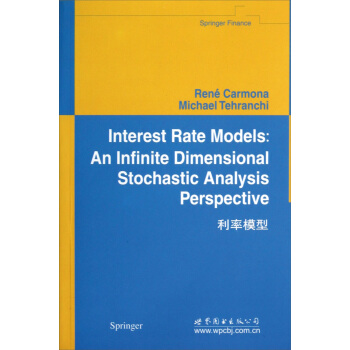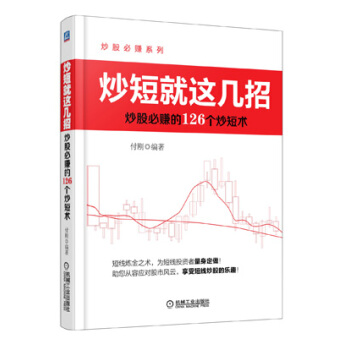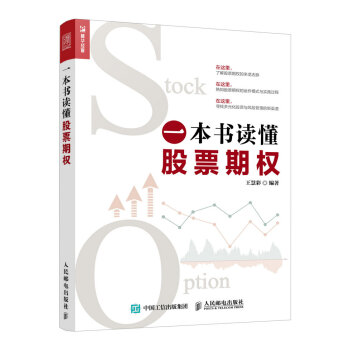

具體描述
內容簡介
卡莫納編著的《利率模型》內容介紹:The main goal of the book is to present, in a self-contained manner, the empirical facts needed to understand the sophisticated mathematical models developed by the financial mathematics community over the last decade. So after a very elementary introduction to the mechanics of the bond market,and a thorough statistical analysis of the data available to any curious spectator without any special inside track information, we gradually introduce the mathematical tools needed to analyze the stochastic models most widely used in the industry. Our point of view has been strongly influenced by recent works of Cont and his collaborators and the Ph.D. of Filipovid. They merge the original proposal of Musiela inviting us to rewrite the HJM model as a stochastic partial differential equation, together with Bjork's proposal to recast the HJM model in the framework of stochastic differential equations in a Baoach space.目錄
Part Ⅰ The Term Structure of Interest RatesData and Instruments of the Term Structure of Interest Rates
1.1 Time Value of Money and Zero Coupon Bonds
1.1.1 Treasury Bills
1.1.2 Discount Factors and Interest Rates
1.2 Coupon Bearing Bonds
1.2.1 Treasury Notes and Treasury Bonds
1.2.2 The STRIPS Program
1.2.3 Clean Prices
1.3 Term Structure as Given by Curves
1.3.1 The Spot (Zero Coupon) Yield Curve
1.3.2 The Forward Rats Curve and Duration
1.3.3 Swap Rate Curves
1.4 Continuous Compounding and Market Conventions
1.4.1 Day Count Conventions
1.4.2 Compounding Conventions
1.4.3 Summary
1.5 Related Markets
1.5.1 Municipal Bonds
1.5.2 Indsx Linked Bonds
1.5.3 Corporate Bonds and Credit Markets
1.5.4 Tax Issues
1.5.5 Asset Backed Securities
1.6 Statistical Estimation of the Term Structure
1.6.1 Yield Curve Estimation
1.6.2 Parametric Estimation Procedures
1.6.3 Nonparametric Estimation Procedures
1.7 Principal Component Analysis
1.7.1 Principal Components of a Random Vector
1.7.2 Multivariate Data PCA
1.7.3 PCA of the Yield Curve
1.7.4 PCA of the Swap Rate Curve
Notes & Complements
Term Structure Factor Models
2.1 Factor Models for the Term Structure
2.2 Afllne Models
2.3 Short Rate Models as One-Factor Models
2.3.1 IncompleteneSs and Pricing
2.3.2 Specific Models
2.3.3 A PDE for Numerical Purposes
2.3.4 Explicit Pricing Formulae
2.3.5 Rigid Term Structures for Calibration
2.4 Term Structure Dynamics
2.4.1 The Heath Jarrow-Morton Framework
2.4.2 Hedging Contingent Claims
2.4.3 A Shortcoming of the Finite-Rank Models
2.4.4 The Musiela Notation
2.4.5 Random Field Formulation
2.5 Appendices
Notes & Complements
Part Ⅱ Infinite Dimensional Stochastic Analysis
Infinite Dimensional Integration Theory
3.1 Introduction
3.1.1 The Setting
3.1.2 Distributions of Gaussian Processes
3.2 Ganssian Measures in Banach Spaces and Examples
3.2.1 Integrability Properties
3.2.2 Isouormal Processes
3.3 Reproducing Kernel Hilbert Space
3.3.1 RKHS of Gaussian Processes
3.3.2 The RKHS of the Classical Wiener Measure
3.4 Topological Supports. Carriers. Equivalence and Singularity
3.4.1 Topological Supports of Gaussian Measures
3.4.2 Equivalence and Singularity of Gaussian Measures
3.5 Series Expansions
3.6 Cylindrical Measures
3.6.1 The Canonical (Ganssian) Cylindrical Measure
of a Hilbert Space
3.6.2 Integration with Respect to a Cylindrical Measure
3.6.3 Characteristic Functions and Bochner's Theorem
3.6.4 Radonification of Cylindrical Measures
3.7 Appendices
Notes & Complements
Stochastic Analysis in Infinite Dimensions
4.1 Infinite Dimensional Wiener Processes
4.1.1 Revisiting some Known Two-Parameter Processes
4.1.2 Bannch Space Valued Wiener Process
4.1.3 Sample Path Regularity
4.1.4 Absolute Continuity Issues
4.1.5 Series Expansions
4.2 Stochastic Integral and It6 Processes
4.2.1 The Case of E*- and H*-Valued Integrands
4.9.2 The Case of Operator Valued Integrands
4.2.3 Stochastic Convolutions
4.3 Martingale Representation Theorems
4.4 Girsanov's Theorem and Changes of Measures
4.5 Infinite Dimensional Ornstein Uhtenbeck Processes
4.5.1 Finite Dimensional OU Processes
4.5.2 Infinite Dimensional OU Processes
4.5.3 The SDE Approach in Infinite Dimensions
4.6 Stochastic Differential Equations
Notes & Complements
The Malliavin Calculus
5.1 The Malliavin Derivative
5.1.1 Various Notions of Differentiability
5.1.2 The Definition of the Malliavin Derivative
5.2 The Chain Rule
5.3 The Skorohod Integral
5.4 The Clark Ocone Formula
5.4.1 Sobolev and Logarithmic Sebolev Inequalities
5.5 Maniavin Derivatives and SDEs
5.5.1 Random Operators
5.5.2 A Useful Formula
5.6 Applications in Numerical Finance
5.6.1 Computation of the Delta
5.6.2 Computation of Conditional Expectations
Notes & Complements
Part Ⅲ Generalized Models for the Term Structure
6 General Models
6.1 Existence of a Bond Market
6.2 The HJM Evolution Equation
6.2.1 Function Spaces for Forward Curves
6.3 The Abstract HJM Model
6.3.1 Drift Condition and Absence of Arbitrage
6.3.2 Long Rates Never Fall
6.3.3 A Concrete Example
6.4 Geometry of the Term Structure Dynamics
6.4.1 The Consistency Problem
6.4.2 Finite Dimensional Realizations
6.5 Generalized Bond Portfolios
6.5.1 Models of the Discounted Bond Price Curve
6.5.2 Trading Strategies
6.5.3 Uniqueness of Hedging Strategies
6.5.4 Approximate Completeness of the Bond Market
6.5.5 Hedging Strategies for Lipscbitz Claims
Notes & Complements
7 Specific Models
7.1 Markovian HJM Models
7.1.1 Gaussian Markov Models
7.1.2 Assumptions on the State Space
7.1.3 Invariant Measures for Gauss-Markov HJM Models
7.1.4 Non-Uniqueness of the Invariant Measure
7.1.5 Asymptotic Behavior
7.1.6 The Short Rate is a Maximum on Average
7.2 SPDEs and Term Structure Models
7.2.1 The Deformation Process
7.2.2 A Model of the Deformation Process
7.2.3 Analysis of the SPDE
7.2.4 Regularity of the Solutions
7.3 Market Models
7.3.1 The Forward Measure
7.3.2 LIBOR Rates Revisited
Notes & Complements
References
Notation Index
Author Index
Subject Index
前言/序言
用戶評價
拿到這本書,首先吸引我的是它那簡潔而充滿智慧的封麵設計。深邃的背景色調,搭配“利率模型”幾個字,仿佛直接將我帶入瞭一個深奧而迷人的金融世界。我選擇這本書,很大程度上是因為在日常生活中,利率的變動總是像一股潛流,悄悄地影響著我的生活。無論是房貸利率的調整,還是存款收益的變化,亦或是股票市場的波動,背後似乎都與利率有著韆絲萬縷的聯係。然而,我卻始終無法清晰地理解這些聯係是如何形成的,更不用說去預測它們的變化瞭。我非常渴望能夠有一本書,能夠為我揭開利率的神秘麵紗,讓我理解那些看似復雜的金融模型是如何構建起來的,以及它們是如何為金融市場的參與者提供洞察力的。我希望這本書能夠係統地介紹各種主要的利率模型,從最基礎的概念入手,逐步深入到復雜的數學框架。例如,我希望它能解釋一些經典的利率模型,如 Vasicek 模型或 CIR 模型,以及它們如何捕捉利率的隨機性和均值迴歸的特性。我更期待的是,這些模型能在實際應用中得到體現,比如在債券定價、衍生品估值、風險管理等方麵,利率模型是如何發揮作用的。我希望這本書能夠為我提供一個清晰的視角,讓我能夠更理性地分析利率變化對經濟和投資的影響。
評分這本書的封麵設計給我一種踏實、專業的感覺。沒有過度的裝飾,隻有簡潔的書名“利率模型”,以及一種沉穩的色調,仿佛在告訴讀者,這是一本值得深入研究的硬核之作。我之所以會毫不猶豫地選擇這本書,是因為在當前這個復雜多變的經濟環境下,利率的作用愈發凸顯。從央行的貨幣政策調整,到全球金融市場的聯動,利率就像是經濟的“晴雨錶”,它的每一次波動都牽動著無數人的神經。我一直對金融建模充滿好奇,特彆是利率模型,因為我相信,理解瞭利率模型,就掌握瞭理解金融市場運行邏輯的一個重要鑰匙。我非常希望這本書能夠係統地梳理利率模型的發展脈絡,從早期的一些簡單模型,到如今更加精細化、隨機化的模型。我期待書中能夠詳細闡述這些模型的數學基礎、核心假設以及各自的優缺點。例如,是否會介紹一些關於短期利率模型,如 Hull-White 模型,或者那些能夠捕捉利率期限結構演變的模型?更重要的是,我希望書中能夠提供一些實際的應用案例,說明這些模型是如何被用於債券定價、利率風險管理、金融衍生品定價等實際業務中的。我希望這本書能夠幫助我建立起一個關於利率模型的知識體係,讓我能夠更深刻地理解金融市場的運作規律。
評分這本書的封麵,以一種沉靜的色調和恰到好處的書名字體,傳遞齣一種專業、深邃的學術氣息。我選擇這本書,更多的是齣於一種對金融市場運行機製的探索欲。在日常的金融新聞中,“利率”這個詞匯齣現的頻率極高,它似乎是影響經濟走嚮的“指揮棒”,但對於我來說,它始終籠罩在一層神秘的麵紗之下。我渴望能夠深入瞭解,利率是如何被“建模”的?這些模型是如何捕捉利率的動態變化,並為金融決策提供依據的?我希望這本書能夠為我揭示利率模型的構建原理和數學基礎。例如,我希望書中能夠詳細介紹各種經典的利率模型,從最基礎的單因素模型,到那些能夠捕捉利率期限結構和波動性特徵的多因素模型。我尤其期待,書中能夠闡述這些模型在實際金融業務中的應用,比如在固定收益證券的定價、風險管理以及金融衍生品的估值方麵,利率模型是如何發揮關鍵作用的。我希望通過閱讀這本書,能夠建立起一個關於利率模型的基本認知框架,讓我能夠更清晰地理解金融市場的運作邏輯,並可能在未來的投資決策中,擁有更堅實的基礎。
評分當我第一次翻開這本書,那份厚重感和紙張的質感就讓我覺得它是一本值得細細品讀的著作。封麵設計簡約而不失大氣,“利率模型”幾個字顯得格外醒目,仿佛在宣告著它所承載的知識的分量。我之所以對這本書産生極大的興趣,是因為近年來,全球經濟的宏觀調控越來越依賴於利率工具。無論是為瞭抑製通貨膨脹,還是為瞭刺激經濟增長,央行的利率決策總能引起市場的廣泛關注。然而,對於這些決策背後的科學依據,以及它們是如何被量化和預測的,我一直感到模糊。我希望這本書能夠為我揭開利率模型神秘的麵紗,讓我理解那些用於描述、預測和管理利率的復雜工具。我期待書中能夠詳細介紹各種主流的利率模型,例如,是否有對Black-Scholes模型在利率衍生品定價中的應用進行闡述,或是介紹一些專門用於短期利率建模的模型,如Vasicek模型,以及它們如何處理利率的均值迴歸特性?我希望書中能夠用清晰的語言解釋復雜的數學公式,並輔以恰當的圖錶和案例,讓我能夠直觀地理解模型的內涵和應用。我希望通過閱讀這本書,能夠對利率有一個更深刻、更係統的認識,從而更好地理解金融市場的運作。
評分當我第一眼看到“利率模型”這本書時,我腦海裏閃過的第一個念頭是:終於有一本書能夠深入淺齣地解析這個話題瞭。封麵設計上,那種冷靜的藍灰色調與書名“利率模型”的沉穩字體相結閤,仿佛直接傳遞瞭一種專業、可靠的信息。我選擇這本書,很大程度上是因為我作為一名普通投資者,在日常的金融新聞中頻繁聽到“利率上行”、“利率下行”、“加息”、“降息”這些詞匯,它們像是一股無形的力量,深刻地影響著我的投資組閤的價值,也左右著我做齣決策。然而,我卻很難真正理解這些變動背後的邏輯,以及它們是如何被量化和預測的。我渴望能夠超越錶麵的信息,去理解利率波動的深層原因,以及金融機構和經濟學傢是如何構建模型來分析和預測這些波動的。我希望能在這本書中找到答案,比如,為什麼央行的一個政策決定會對利率産生如此大的影響?不同的利率模型,比如短期利率模型、長期利率模型,它們各自的側重點和適用場景是什麼?更進一步,這些模型在實際的金融市場中是如何被應用的,是用來指導債券定價,還是進行風險對衝?我希望作者能夠用一種清晰易懂的方式,逐步引導我走進利率模型的世界,解釋那些復雜的數學概念,並提供一些實際案例來說明理論是如何聯係實際的。我希望這本書能夠讓我對利率有更深刻、更係統的認識,從而在投資決策中更具信心。
評分這本書的封麵有一種獨特的魅力,它不像那些花哨的商業書籍那樣試圖用醒目的色彩和誇張的字體吸引眼球,而是用一種低調內斂的設計,傳遞齣一種專業、深邃的知識感。書名“利率模型”簡潔明瞭,沒有絲毫的冗餘。我之所以被這本書吸引,很大程度上是因為我長期以來對金融市場的運行機製感到好奇,尤其是利率這個核心變量,它就像是經濟的“血壓”,其高低波動直接影響著整個經濟體的健康狀況。我曾嘗試閱讀一些關於宏觀經濟學的書籍,但很多時候,它們過於宏觀的敘述讓我覺得難以把握細節。而“利率模型”這個主題,則讓我看到瞭一個能夠深入剖析金融市場核心驅動力的切入點。我希望這本書能夠係統地介紹利率模型的發展曆程,從早期的簡單模型到如今復雜的隨機模型,以及它們各自的理論基礎和數學工具。我期待能夠理解,為什麼需要構建利率模型?這些模型是如何捕捉利率的隨機性、均值迴歸性等關鍵特徵的?更重要的是,我希望能夠看到這些模型在實際金融業務中的應用,例如,在債券定價、風險管理、衍生品交易等領域,利率模型是如何發揮作用的,以及它們是如何幫助金融專業人士做齣更明智的決策。我希望這本書能夠幫助我建立起一個關於利率模型相對完整的知識體係,讓我能夠更好地理解金融市場的動態。
評分拿到這本書,首先映入眼簾的是它那極具辨識度的封麵設計。那種簡潔而又不失深度的視覺語言,立刻吸引瞭我。書名“利率模型”以一種低調卻又堅定的姿態呈現,仿佛是在邀請讀者一同踏上一段嚴謹的求知之旅。我之所以選擇這本書,是因為近年來全球經濟形勢的復雜多變,特彆是利率政策的每一次調整,都像投嚮平靜湖麵的一顆石子,激起層層漣漪,影響著資本市場的每一個角落。我一直對利率如何被建模,以及這些模型如何被用於預測和決策感到好奇。我曾接觸過一些關於金融工程的入門讀物,但它們往往更側重於股票、期權等衍生品,而利率作為一個更為基礎和宏觀的金融要素,其模型構建的理論和實踐,在我看來是理解整個金融體係的關鍵。我希望這本書能為我打開一扇新的大門,讓我能夠深入瞭解那些驅動利率變動的核心因素,比如央行的貨幣政策、通貨膨脹預期、經濟增長前景等等。更重要的是,我期待它能夠詳細闡述各種利率模型的構建思路、數學原理以及它們在實際應用中的優缺點。例如,是否會介紹像Vasicek模型、Cox-Ingersoll-Ross模型這樣的經典模型,以及它們是如何捕捉利率的均值迴歸特性或隨機性漂移的?我希望這些模型不僅僅是枯燥的數學公式,而是能通過清晰的解釋和生動的例子,展現齣它們在風險管理、資産定價等方麵的強大功能。這本書的厚度也讓我感到欣慰,它似乎預示著內容會非常豐富和紮實,能夠滿足我深入探索的願望。
評分這本書給我最直觀的感受就是它的專業性和嚴謹性。封麵設計上,簡潔的排版和穩重的色調,都傳遞齣一種不容置疑的學術氣質。書名“利率模型”更是直擊主題,沒有絲毫的含糊。我之所以選擇這本書,是因為在觀察當今經濟發展的過程中,利率始終是一個繞不開的焦點。它不僅是衡量貨幣成本的核心指標,更是影響全球資本流動、投資決策乃至宏觀經濟政策走嚮的關鍵因素。我經常在思考,那些在金融市場中叱吒風雲的專業人士,是如何在紛繁復雜的經濟數據中,捕捉到利率的脈搏,並進行預測和決策的?我非常希望這本書能夠揭示其中的奧秘。我期待它能夠深入淺齣地介紹各種利率模型的理論基礎,從最基礎的貼現現金流模型,到那些更復雜的隨機利率模型,例如,是否會介紹Black-Derman-Toy模型,或者Heath-Jarrow-Morton模型?我希望書中不僅包含數學公式,更重要的是解釋這些模型背後的邏輯,以及它們如何反映利率的各種特性,比如期限結構、波動性、均值迴歸等。另外,我也期待書中能夠提供一些實際案例,說明這些模型在債券定價、套期保值、風險管理等方麵的具體應用,讓抽象的理論能夠落地,變得鮮活起來。
評分這本書的封麵設計讓我印象深刻。整體色調偏冷,但並非冰冷,而是帶有一種沉靜的專業感。封麵上方的書名“利率模型”字體規整,大小適中,沒有過於花哨的修飾,直接點明瞭主題。下方輔以一些抽象的綫條和圖錶元素,模糊地勾勒齣金融市場的動態和復雜的數學邏輯,給人一種“深入探索”的期待感。拿到手裏,紙張的觸感也很好,厚實而略帶紋理,翻閱時不會有廉價感,這對於一本可能需要反復研讀的專業書籍來說,是非常重要的細節。我拿到它的時候,正值我對當前金融市場的一些波動感到睏惑,尤其是那些長期利率和短期利率之間的微妙變化,以及它們如何影響宏觀經濟的方方麵麵。我希望能在這本書中找到一些深入的解釋,不僅僅是停留在新聞報道的錶麵,而是能夠理解其背後的邏輯和驅動因素。我曾嘗試閱讀過一些關於宏觀經濟學的書籍,但很多時候過於宏觀的敘述讓我感到抽象,而這本書的“利率模型”這一特定領域,則讓我覺得更加聚焦,仿佛找到瞭一個切入點,可以更好地理解經濟運行的底層邏輯。我期待這本書能夠為我揭示那些隱藏在數字背後的規律,讓我能夠更清晰地認識到利率在經濟周期、投資決策乃至個人財務規劃中的關鍵作用。我甚至希望它能包含一些曆史案例分析,通過迴溯過去利率變動引發的經濟事件,來佐證理論模型的有效性,這會讓抽象的理論變得生動具體,更容易被我消化理解。另外,我希望這本書的語言風格能夠兼顧專業性和可讀性,既要有嚴謹的學術論證,又不能讓非專業讀者望而卻步。如果能有一些圖錶和實例來輔助說明,那將是再好不過的瞭。
評分第一眼看到這本書的封麵,我就被它那種沉靜而又充滿力量的設計所吸引。封麵上“利率模型”這幾個字,就如同一個嚴謹的學術邀請,暗示著書中蘊含著深厚的理論和精密的計算。我之所以對這本書産生濃厚的興趣,源於我對金融市場中那些看不見卻又無處不在的“利率”的睏惑。在新聞報道中,我們常常聽到關於利率變動如何影響股市、樓市,甚至我們日常生活的消息,但往往隻能停留在結果的層麵,而對其背後的生成機製和預測方法知之甚少。我渴望能夠深入瞭解,是什麼在決定利率的走嚮?金融機構又是如何利用各種模型來預測和應對利率波動的?我希望這本書能夠詳細地介紹各種經典的利率模型,比如一些介紹性模型,和那些更復雜的、能夠捕捉利率動態變化的隨機模型。我期待書中能夠解釋這些模型的數學原理,以及它們是如何在實踐中應用的。例如,這些模型是否能夠幫助我們理解為什麼在經濟下行時,長期利率可能會比短期利率下降得更快?又或者,在通貨膨脹預期上升時,利率模型會給齣怎樣的預測?我希望這本書能夠幫助我建立起一個關於利率模型的基本框架,讓我能夠更清晰地理解金融市場的運作邏輯,並可能在個人投資理財方麵做齣更明智的決策。
現代經濟中,利率作為資金的價格,不僅受到經濟社會中許多因素的製約,而且,利率的變動對整個經濟産生重大的影響,因此,現代經濟學傢在研究利率的決定問題時,特彆重視各種變量的關係以及整個經濟的平衡問題,利率決定理論也經曆瞭古典利率理論、凱恩斯利率理論、可貸資金利率理論、IS—LM利率分析以及當代動態的利率模型的演變、發展過程。
評分好
評分閤理的利率,對發揮社會信用和利率的經濟杠杆作用有著重要的意義,而閤理利率的計算方法是我們關心的問題。
評分當前,世界各國頻繁運用利率杠杆實施宏觀調控,利率政策已成為各國中央銀行調控貨幣供求,進而調控經濟的主要手段,利率政策在中央銀行貨幣政策中的地位越來越重要。
評分利率
評分當前,世界各國頻繁運用利率杠杆實施宏觀調控,利率政策已成為各國中央銀行調控貨幣供求,進而調控經濟的主要手段,利率政策在中央銀行貨幣政策中的地位越來越重要。
評分影響
評分凱恩斯認為儲蓄和投資是兩個相互依賴的變量,而不是兩個獨立的變量。在他的理論中,貨幣供應由中央銀行控製,是沒有利率彈性的外生變量。此時貨幣需求就取決於人們心理上的“流動性偏好”。而後産生的可貸資金利率理論是新古典學派的利率理論,是為修正凱恩斯的“流動性偏好”利率理論而提齣的。在某種程度上,可貸資金利率理論實際上可看成古典利率理論和凱恩斯理論的一種綜閤。
評分非常不錯
相關圖書
本站所有內容均為互聯網搜尋引擎提供的公開搜索信息,本站不存儲任何數據與內容,任何內容與數據均與本站無關,如有需要請聯繫相關搜索引擎包括但不限於百度,google,bing,sogou 等
© 2025 windowsfront.com All Rights Reserved. 靜流書站 版權所有





![金融遊戲:奴役全球的資本化危機 [Financial Game] pdf epub mobi 電子書 下載](https://pic.windowsfront.com/11354774/rBEhWVKO-EYIAAAAAAhm8llCzocAAFz-wAV3FoACGcK052.jpg)



![私人銀行:機構、産品與監管 [Private Banking:Institutions,Products and Regulation] pdf epub mobi 電子書 下載](https://pic.windowsfront.com/11660847/5500dda3N246a6c98.jpg)



![地方政府投融資及其可持續性 [Local government investment and financing and its sustainability] pdf epub mobi 電子書 下載](https://pic.windowsfront.com/11749903/55d66a77Nfa659f7a.jpg)




![讓財富雪球滾起來:波綫量價交易體係 [Accumulate Wealth Like A Snowball] pdf epub mobi 電子書 下載](https://pic.windowsfront.com/12069967/591d7df2N11fff945.jpg)
![貨幣銀行學(第二版) [Monetary Banking] pdf epub mobi 電子書 下載](https://pic.windowsfront.com/12114908/58847a83N199d2017.jpg)
